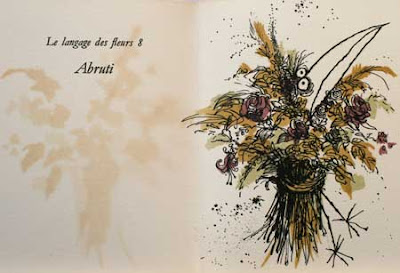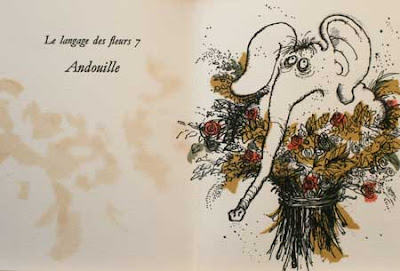Ronald Searle, the theater in Paris (1954-1962) until December 9 at Galerie Martine Gossieaux, 56, rue de l'Université, Paris VII.
It's not quite a book but a sumptuous catalog of an exhibition of drawings by Ronald Searle. Portraits, caricatures of the great actors of the Parisian scene between 1954 and 1962, Jean-Louis Barrault, Pierre Brasseur, Edwige Feuillère, Madeleine Renaud, Françoise Rosay, Paul Meurice, Michel Bouquet, Suzanne Flon, Marcel Marceau, Yves Robert, Elvire Popesco Francois Perier, Robert Hirsch, Bernard Blier, Jean-Louis Trintignant, Daniel Ivernel and some other beautifully reproduced next to the facsimile theater posters at the time, and sometimes a program or a review. Ronald Searle is English and his funny signature whose letters appear swollen up from the floor with helium, betrays this rare feature for a man of his generation Searle writes and draws with his left hand, nobody has managed to annoy .
At the time, the Punch newspaper had already more than 100 years (established in 1841) and still afford to maintain at Paris a theater critic and send them as often as possible, a specialized designer. Searle recalls: "He was called Eric Keown, we were inseparable, known as Laurel and Hardy, I was the little beard that I'm still, he was 6 feet 8 inches, something like 2.07 meters, no could see anything sitting behind him. His uncle had been the teacher of Samuel Beckett, we became friends, we had lunch all three regularly Beckett always sat next to the toilet, and every quarter of an hour, he went there without explanation it was very funny, but did not we laugh. If I told him: "Godot is God, is God, right?" He replied: "No, I chose this name in the phone book." He said: "In my school, the first prize received a volume speeches of Churchill, the second received two volumes. '" Ronald Searle likes to remember, but these sketches of theater are just a pretext ("Besides I hated doing caricatures, it is too difficult "), the memories that live there are older, they have haunted him all his life. Four years a prisoner of the Japanese and forced labor on the bridge over the River Kwai, the death grazed, the horror of the stomach ...
Resume. Ronald Searle was born in Cambridge in 1920: "There, we English since the Normans, or the Vikings if these people never existed before the English. Cambridge is our Auvergne, are grown peonies and rheumatism, you know, peonies, these flowers are made with opium, "poppy" you say ... Yes, I live in France for forty years, this is a difficult language and English are slow (Searle speaks perfect French, with a slight accent as he cultivates his exquisitely fine beard). My father repaired phones, which is why we had the privilege of having the phone so that customers can call my father, but rarely seen calling their phone was broken. He died of the disease cycle, I mean the incessant rain which waters you when you are forced to wade through the township bicycle. Well, I was born in a country where the climate is fatal. "
At age 15, Ronald Searle drawing up its first (20 shillings), and has not stopped since, "the artist of the family, it was my grandfather, he was a watchmaker village, he made that called "grand-father clocks", clocks comtoises more than 2 meters, he went door-to-door, the compliment was to convince farmers to dig a hole 40 centimeters into the ground to make their kitchen keep the clock under the ceiling. He drew the dials, they are now in museums. He had a special gift of the gab, his own grandfather was Oratorian, he was hanged as a heretic. Do not worry, we hung easily in England. "
"A massacre." "In 1938, when Chamberlain returned from Munich, saying:" It is peace, "we knew it was war. I engaged in engineering because I knew they had trucks, we learned to be wary of the bicycle in the family. "Searle is sent to the Far East, he will spend the bulk of its war prisoner. "This is the war that has made me an artist, I started to draw the reality to" mom and little dog "had no meaning. The Japanese had eight years of war behind them, they came from Malaysia, we were more and more idiots. It was a massacre. They pushed us in Singapore, the island was crowded, we were off the water. We went. We fools farmers Cambridge, we were led to believe with their slanted eyes, they could not fire a gun! Result: 35,000 Japanese prisoners were 70,000 English and other allies (Australians, Indians, Dutch). "
Ronald Searle spent four years in camp in Singapore. He draws, he will, with his only pencil, "the great camera of the war," he assigns this duty keeps him alive. Then it was requisitioned in Thailand to go build the railway line which must supply the Japanese army, which will cross the legendary River Kwai: "Everyone was against us, the natives, snakes, Japanese. I got there a skin disease which prevents me from traveling even in wet (since when stories lead me, I send my wife to buy postcards that I redraw the hotel) . We worked fourteen hours a day on 70,000 prisoners, only 25,000 survived, the 250 men of my company, I am the only survivor. The natives were all massacred. There was one death crosses the railway. I hid my drawings in the body the dying and the dead that the Japanese refused to touch for fear of epidemics, typhus, cholera. I saved 300 drawings, they are at the War Museum in London. "
"Job ridiculous." "I do not hate the Japanese, but the hierarchy. They did not eat more than us, they were just more courageous, I admired.You learn to be strong only because we know they can not go lower. I was 22 years old, every morning I woke up next to a dead colleague. I learned that in any event there are people and human bastards in each camp. We had news from the BBC. In August 1945, we had come from Ceylon dropped leaflets saying, "If you are alive, do nothing, you will be released in a few months." Then they dropped bags of rice and two intelligence officers. The Japanese were ordered to execute prisoners.They refused. Many have done hara-kiri. "
Well, these are only five or six years in the life of a 80 year old man, so he no longer wanted to talk about the rest: "After that, we know we made a ridiculous job, I 'm just vowed not to make jokes in my drawings. "Back in London, Searle knows a tremendous success with the St. Trinian's, the adventures of a band of Scottish minxes College. A success that eventually stifle, like his friend Jean-Jacques Sempé with Petit Nicolas. The St. Trinian's (he left in 1953) are now in Penguin Classic, between Kafka and Virginia Woolf. We shot five feature films Searle believes that "disastrous". In 1961, a groggy put it deems moved glory, Searle moved to Paris. He became a reporter for the largest designer American magazines, it follows the Eichmann trial in Jerusalem ("A drawing by impassible day type"), Kennedy's election ("Nixon said:" In Africa, the situation is not so black as that. '"), makes animated films in Hollywood. Today, Ronald Searle drawing for the world and lives in the Var, he drinks sancerre left hand, loves fried smelts and forgot nothing.



















































